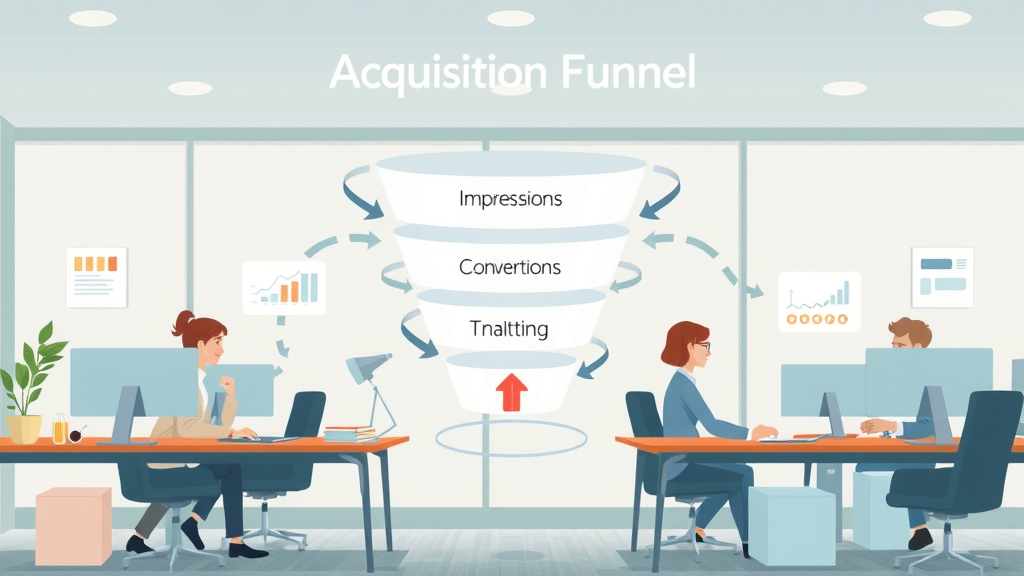Imagine doubling your digital marketing growth simply by tracking the right cost per acquisition models . Businesses that excel at monitoring and optimizing their acquisition cost outperform competitors—transforming underperforming campaigns into powerful drivers of customer acquisition and high return on investment. This comprehensive guide will show you exactly how to master cost per acquisition models, turning every ad spend into measurable growth for your business.
Surprising Facts About Cost Per Acquisition Models and Digital Marketing Success
"Businesses that accurately track their cost per acquisition models are 2x more likely to achieve sustainable growth in digital marketing campaigns."

Understanding Why Cost Per Acquisition Models Matter in Customer Acquisition
In the world of digital marketing, cost per acquisition models are the backbone of every smart marketing strategy. Knowing your acquisition cost means more than just tracking how much is spent to get a paying customer—it provides a clear lens through which to view the efficiency and impact of your marketing efforts . When you understand and optimize these models, your marketing campaign becomes a finely tuned machine, leveraging every marketing channel —from online advertising to social media—and delivering results that surpass expectations.
A solid grasp of these models lets you make informed decisions about budget allocation, ad spend, and even messaging on every landing page. For example, adjusting your ad campaign based on real-time acquisition cost data can instantly boost conversion rate and lower CPA . As marketing leaders recognize, focusing on the true cost per acquisition is essential for creating sustainable, scalable growth and maximizing return on investment .
Essentials: What You'll Master About Cost Per Acquisition Models
- How to define, calculate, and interpret different types of cost per acquisition models
- The impact of cost per acquisition models on digital marketing strategy
- Optimizing acquisition cost across customer acquisition funnels
- Proven ways to improve conversion rate and return on investment
- Real-world examples and actionable steps for optimizing your marketing budget
Demystifying Cost Per Acquisition Models: Definitions and Key Principles
What is the Cost Per Acquisition Model?
The cost per acquisition (CPA) model is a critical marketing metric that calculates the total cost required to secure one specific action —most often a new paying customer. In simple terms, it’s how much you spend, on average, for each conversion from your marketing campaigns . CPA serves as a practical yardstick for tracking the efficiency of your ad spend and measuring customer acquisition across all marketing channels. Whether you’re running a Facebook ad, an intricate email series, or broad online advertising, knowing your cost per acquisition helps ensure your marketing budget is working as hard as possible.

Distinguishing Between Acquisition Cost Model and Cost Per Acquisition
While “ acquisition cost model ” and “cost per acquisition” are sometimes used interchangeably, there’s an important distinction. The acquisition cost model represents the broader framework for measuring any expense involved in acquiring a new customer, from online ad spend to ongoing marketing efforts . The cost per acquisition, however, usually refers specifically to the cost involved in generating a single conversion—making it a focused tool for marketing strategies and budget optimization.
Understanding both concepts allows marketers to align their campaign goals with the right performance metrics . For instance, an e-commerce business might use an acquisition cost model to evaluate the total cost across all campaigns, while also monitoring the specific CPA of a targeted Facebook ad. Accurate analytics at both levels empower brands to adjust their marketing strategies and maximize return on ad spend .
Breaking Down the Key Types of Cost Per Acquisition Models
CPA in Digital Marketing: Models For Every Marketing Strategy
Not all cost per acquisition models are created equal. In today’s digital marketing ecosystem, marketers employ a range of CPA models to match different goals, products, and customer journeys. The three most common types—Pay-Per-Lead, Pay-Per-Sale, and Blended CPA—help you align your marketing strategies with specific business needs. The choice of model dramatically influences both your marketing budget allocation and how you judge the success of your marketing campaign .
For example, a SaaS company focused on free trial signups may prioritize Pay-Per-Lead CPA, whereas an e-commerce retailer measuring direct sales will concentrate on Pay-Per-Sale. Multi-channel brands can benefit from a blended approach, calculating a unified cost per acquisition across web, social, and email. Understanding which model fits your target audience and marketing effort will help you optimize every dollar spent.
Cost Per Acquisition Model Calculation Table
| Model Type | Formula | Best Use Case |
|---|---|---|
| Pay-Per-Lead | Total Ad Spend ÷ Number of Leads | Lead Generation for Services |
| Pay-Per-Sale | Total Ad Spend ÷ Number of Sales | E-commerce Sales |
| Blended CPA | Total Ad Spend ÷ (Leads + Sales) | Multi-Channel Marketing |

Landing Page Optimization for Powerful Cost Per Acquisition Models
Linking Landing Page Design and Conversion Rate to Acquisition Cost
The landing page is where your ad campaign meets the potential customer. If your design is cluttered, slow, or poorly messaged, every visitor that bounces away is an opportunity (and an ad dollar) lost. An optimized landing page can dramatically lower CPA by boosting conversion rate , turning more clicks into completed actions. That’s why the best digital marketers treat landing page optimization as a direct route to better cost per acquisition performance.
To maximize efficiency, build dedicated landing pages for each marketing channel and tailor content to the audience’s mindset. Use clear calls to action, fast loading speeds, and eye-catching visuals aligned with your digital marketing messaging. Routinely perform A/B testing to refine layouts and forms, so that even small improvements in conversion rate can lead to substantial savings in acquisition cost .

Case Study: How Landing Pages Cut Cost Per Acquisition by 30%
Take, for example, an e-commerce brand investing in online advertising to drive product sales. By redesigning their landing page using conversion-focused best practices – including personalized headlines, social proof, and simplified forms – they boosted their conversion rate from 5% to 7%. As a result, the brand’s cost per acquisition dropped by 30%, freeing up budget to expand their marketing campaign and acquire even more customers.
This case demonstrates how small UX/UI improvements can have a dramatic impact on overall marketing efficiency . Optimizing every step in your customer acquisition funnel pays major dividends for both your bottom line and your return on investment .
How Cost Per Acquisition Models Drive Customer Acquisition
Aligning Customer Acquisition and Digital Marketing Strategy
Effective customer acquisition begins with a data-driven understanding of acquisition cost . When businesses integrate cost per acquisition models into strategic planning, each marketing effort is aimed at measurable growth. CPA metrics provide feedback throughout the funnel—highlighting which ad campaigns and channels best convert the target audience into customers.
By setting CPA goals and tracking them alongside conversion rate and return on investment , you can fine-tune your marketing strategy for sustainable growth. Leading marketers regularly reassess CPA data in light of changing trends, customer lifetime value, and expanding marketing channels. The result is a dynamic approach that turns every marketing campaign into a revenue engine.

Adjusting Ad Campaigns for Lower Acquisition Cost
Reducing acquisition cost is as much an art as a science. Successful organizations actively manage ad spend , pausing underperforming creatives and reallocating budget toward high-performing ads or landing pages . For example, ongoing review of ad campaign performance using CPA metrics can reveal when to optimize ad copy, adjust targeting, or test new marketing channels .
Real-time analytics have made it easier than ever to make swift changes. Integrating CPA goals with ad management platforms allows for automatic bid adjustments based on live campaign results. This kind of adaptive marketing ensures you never overspend to acquire a potential customer , safeguarding your marketing budget and amplifying return on ad spend .
Measuring Success: Benchmarks and Tracking for Cost Per Acquisition Models
What Is a Good Cost Per Acquisition for My Business?
Determining what counts as a “good” cost per acquisition depends on your industry, pricing, and customer lifetime value . For fast-moving e-commerce, a strong CPA might fall between $20 and $30, while in B2B needed CPAs may go higher because of longer sales cycles and greater marketing effort . Benchmarking your results against industry averages offers a valuable reference point—guiding smarter budget allocations and highlighting opportunities to lower CPA further.

CPA Ratios: Setting Targets for ROI and Conversion Rate
Tracking your CPA ratios – the relationship between ad spend, acquisitions, and revenue – is essential for maximizing return on investment . Set targets by considering the value each paying customer brings over their lifetime, and continually optimize your marketing campaign to keep acquisition costs well below this threshold. Monitoring both channel-specific CPA and blended CPA can help you spot trends and refine future marketing strategies.
| Industry | Good CPA (USD) | Average CPA (USD) | Benchmark Source |
|---|---|---|---|
| E-commerce | 25 | 45 | Wordstream |
| B2B | 50 | 75 | Hubspot |
| Finance | 60 | 90 |
Optimizing Your Marketing Budget with Cost Per Acquisition Models
Budget Allocation Tips: Managing Acquisition Cost Across Channels
- Allocate budget to high-converting ads and landing pages
- Pause underperforming ad campaigns
- Monitor blended CPA vs. channel-specific CPA
- Adjust bidding strategies in real time

How Conversion Rate Affects Acquisition Cost Efficiency
Improving conversion rate is the fastest way to lower CPA and maximize marketing budget . Small tweaks to your landing page , audience targeting, or offer structure can increase the number of customers acquired per dollar spent. Pay close attention to bottlenecks in your customer acquisition funnel—testing and optimizing each touchpoint to move more leads towards conversion.
Marketers who master the balance between conversion rate and cost per acquisition regularly outperform their industry peers. Tracking these metrics together ensures your marketing strategy continually delivers maximum return on investment .
Best Practices: Elevating Return On Investment Through Cost Per Acquisition Models
Integrating Return On Investment Analysis with Acquisition Cost Metrics
- Track CPA in relation to customer lifetime value
- Attribute conversions accurately across the funnel
- Test A/B variations for landing pages and digital marketing campaigns
"Conversion rate optimization can lower acquisition costs by 50%—fueling both ROI and sustainable growth."

Discover industry insights as top digital marketing experts evaluate the strengths and weaknesses of the most popular cost per acquisition models. Learn how Pay-Per-Lead, Pay-Per-Sale, and Blended CPA models are implemented in real businesses — and which model could unlock faster growth for your next marketing campaign.
Step-by-step guidance for configuring CPA tracking in leading analytics platforms like Google Ads, Facebook Ads Manager, and HubSpot. Find out how to set up conversion actions, monitor acquisition cost in real time, and use CPA data to optimize every aspect of your digital marketing campaigns.
People Also Ask: What is the cost per acquisition model?
The cost per acquisition model is a performance-based marketing metric that calculates how much it costs your business to acquire a single customer or specific action through marketing campaigns . You determine your CPA by dividing your total ad spend by the number of successful acquisitions, whether those are sales, leads, or other key conversions.
People Also Ask: What is the acquisition cost model?
The acquisition cost model provides a broader measurement of all costs—advertising, promotions, operational expenses—associated with attracting and converting a potential customer into a paying customer. It’s critical for evaluating overall business efficiency and profitability, not just digital campaigns but every channel used in the customer acquisition process.
People Also Ask: What is a good cost per acquisition?
A “good” cost per acquisition is one that generates positive return on investment and fits your industry’s benchmarks. For example, e-commerce businesses may aim for a CPA of $25–$40, while B2B or finance can see higher, justified by higher customer lifetime value. Compare your CPA to industry averages and ensure it’s well below your average profit per customer.
People Also Ask: What is a good CPA ratio?
A strong CPA ratio is when your revenue from each customer far exceeds the acquisition cost . As a rule of thumb, aim for a CPA that is no more than 30–40% of your customer lifetime value. Continually review this ratio as your marketing channels and product strategy evolve.
Step-by-Step Guide to Implementing Cost Per Acquisition Models
- Determine your key conversion actions and goals
- Analyze historical acquisition cost data
- Select the optimal CPA model for your marketing strategy
- Optimize landing pages to boost conversion rate
- Monitor and adjust ad campaign budgets in real time

Frequently Asked Questions on Cost Per Acquisition Models
-
How do I calculate cost per acquisition for multi-channel campaigns?
Add the total ad spend from all marketing channels and divide it by the sum of all conversions generated across those channels. This blended CPA gives a comprehensive view of your overall acquisition efficiency. -
Can cost per acquisition models be used with offline marketing?
Absolutely. CPA can be applied to offline efforts such as trade shows or direct mail if you track conversions generated by those sources. Use unique codes or dedicated landing pages to attribute offline leads and sales. -
How often should I reassess my CPA targets?
Review your CPA targets at least quarterly, or whenever you launch a new campaign, enter a new market, or see significant changes in conversion rate. Regular reviews keep CPA aligned with evolving business goals.
Inspiring Case Studies: Rapid Growth With Optimized Cost Per Acquisition
Case Study 1: SaaS Startup Slashes Acquisition Cost by 40%
A fast-growing SaaS startup used segmented marketing channels and micro-targeted landing pages to drive a 40% reduction in cost per acquisition . They regularly A/B tested their content, iterated quickly, and optimized each step in the customer acquisition funnel . As a result, their quarterly paying customer count doubled without increasing their overall marketing budget.
This commitment to CPA monitoring and rapid experiment cycles enabled them to invest their savings directly into scaling, outpacing competitors and achieving industry-leading ROI.
Case Study 2: E-commerce Brand Doubles ROI Using Blended Acquisition Cost Models
An established e-commerce company adopted a blended CPA model to track multichannel campaigns—including online ads, social media, and email marketing. By integrating their analytics and tracking conversion rate at every touchpoint, they identified their highest-performing channels and reallocated budgets for maximum efficiency. The outcome: a 100% increase in ROI, with new paying customers from both digital and traditional marketing strategies .

Strategies for Continuous Improvement in Cost Per Acquisition Models
- Leverage marketing automation for campaign optimization
- Incorporate data analytics to refine CPA calculations
- Schedule regular reviews of conversion rate trends
- A/B test landing pages and tailor them by customer segments
Learn from real-world examples —both wins and mistakes. This video collection features brands dissecting triple-digit savings, common errors like failing to track channel-specific CPA, and innovative tips for integrating cost per acquisition models across evolving digital marketing efforts.
Key Takeaways for Implementing Winning Cost Per Acquisition Models
- Precise CPA tracking drives growth in digital marketing
- Landing page optimization and conversion rate are essential levers
- Aligning acquisition cost with ROI supports sustainable business scaling
Your Next Steps With Cost Per Acquisition Models
Take action: Audit your current acquisition costs, choose the right CPA model, and focus your resources on optimizing conversion rate and ROI for every campaign.
To deepen your understanding of cost per acquisition (CPA) models and their application in digital marketing, consider exploring the following resources:
- “CPA Advertising | Cost Per Action Ad Pricing Models Explained”
This article provides a comprehensive breakdown of various CPA pricing models, including Cost-Per-Sale (CPS), Cost-Per-Lead (CPL), and Cost-Per-Install (CPI). It offers insights into how each model functions and their suitability for different marketing objectives. ( performcb.com )
- “CPI, CPE, CPA or all of the above? - how to choose the right model for your mobile user acquisition”
This piece delves into the nuances of selecting appropriate cost models for mobile user acquisition, comparing Cost-Per-Install (CPI), Cost-Per-Engagement (CPE), and CPA. It guides marketers in aligning their acquisition strategies with business goals. ( businessofapps.com )
By reviewing these resources, you’ll gain valuable insights into optimizing your marketing strategies through effective CPA models.
 Add Row
Add Row  Add
Add 




Write A Comment